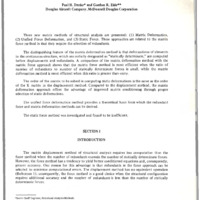The Matrix Deformation Method of Structural Analysis
Item
- Title
- The Matrix Deformation Method of Structural Analysis
- Description
-
Three new matrix methods of structural analysis are presented: (1) Matrix Deformation, (2) Unified Force Deformation, and (3) Static Force. These approaches are related to the matrix force method in that they require the selection of redundants.
The distinguishing feature of the matrix deformation method is that deformations of elements in the continuous structure, which are initially designated as "statically determinate," are computed before displacements and redundants. A comparison of the matrix deformation method with the matrix force approach shows that the matrix force method is most efficient when the ratio of number of redundants to number of statically determinate forces is small, while the matrix deformation method is most efficient when this ratio is greater than unity.
The order of the matrix to be solved in computing static deformations is the same as the order of the K matrix in the displacement method. Compared to the displacement method , the matrix deformation approach offers the advantage of improved matrix conditioning through proper selection of static deformations.
The unified force deformation method provides a theoretical basis from which the redundant force and matrix deformation methods can be derived .
The static force method was investigated and found to be inefficient. - Creator
- Denkem P. H.
- Eide, G. R.
- Abstract
-
Three new matrix methods of structural analysis are presented: (1) Matrix Deformation, (2) Unified Force Deformation, and (3) Static Force. These approaches are related to the matrix force method in that they require the selection of redundants.
The distinguishing feature of the matrix deformation method is that deformations of elements in the continuous structure, which are initially designated as "statically determinate," are computed before displacements and redundants. A comparison of the matrix deformation method with the matrix force approach shows that the matrix force method is most efficient when the ratio of number of redundants to number of statically determinate forces is small, while the matrix deformation method is most efficient when this ratio is greater than unity.
The order of the matrix to be solved in computing static deformations is the same as the order of the K matrix in the displacement method. Compared to the displacement method , the matrix deformation approach offers the advantage of improved matrix conditioning through proper selection of static deformations.
The unified force deformation method provides a theoretical basis from which the redundant force and matrix deformation methods can be derived .
The static force method was investigated and found to be inefficient. - Corporate Author
- Douglas Aircraft Company , McDonnell Douglas Corporation
- Report Number
- AFFDL TR 71-160 p. 85-112
- Publisher
- Wright-Patterson Air Force Base, OH : Air Force Flight Dynamics Laboratory, Air Force Systems Command and Air Force Institute of Technology, Air University
- Date
- 1973
- Type
- article
- Date Issued
- 1973-12
- Provenance
- Bombardier/Aero
- Distribution Classification
- 1
- Distribution Conflict
- No
- DTIC Record Exists
- No
- Report Availability
- Full text available
- Format
- 1 online resource (28 pages) : ill.
- Extent
- 28
- Identifier
- AD0785968
Linked resources
Warning: Undefined array key "id_concat" in /var/www/html/omeka-s/themes/foundation/view/common/linked-resources.phtml on line 40
Warning: Undefined array key "property_alternate_label" in /var/www/html/omeka-s/themes/foundation/view/common/linked-resources.phtml on line 41
Warning: Undefined array key "property_label" in /var/www/html/omeka-s/themes/foundation/view/common/linked-resources.phtml on line 43
| Title | Class |
|---|---|
| Proceedings of the Third Conference on Matrix Methods in Structural Mechanics: Proceedings of the Conference held at Wright-Patterson Air Force Base, Ohio 19-21 October 1971 |
